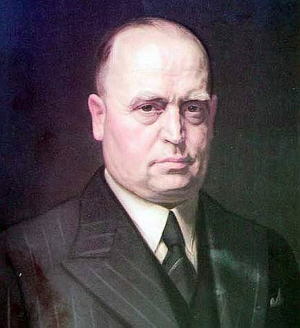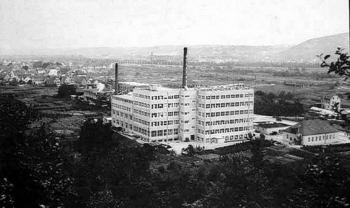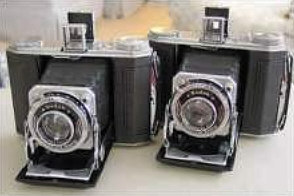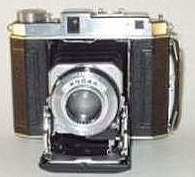|
|
 |
|
K o d a k D u o - 6 2 0
|
The Kodak Duo-620 Story
Article courtesy of Peter Naylor from Perth, Western Australia.
The compact Kodak Duo-620 folder was made from 1933 to 1940 by the Kodak AG/Nagel-Werk in Stuttgart. The "Duo" tag does not refer to dual format capability but to its half-frame format of a nominal 6 X 4.5 cm, giving 16 pics compared to the 8 from the standard 6 X 9 cm format. Other makers sometimes used the term "Semi" instead of "Duo". The "620" part of its title comes from 620 reel film used. There were just three main models of this camera, but thanks to various lens and shutter combinations some 25 variants exist, as listed later. All variants are very compact, the Series 1 especially which is not much bigger than its stablemate the 35mm Retina, but has a useable film area almost three times as big. For those into such things, the surface area of a Retina 24 X 36 mm 35mm film is 864 square mm, compared to 2365 square mm for the Duo-620's actual useable area of 57 X 41 mm.
History
Before getting into the model specifics, let's take a look at the background of the Kodak/Nagel-Werk. We have to start with the boss himself, Dr. August Nagel, who was born in 1867 and died in 1943. The picture below shows him at age 73. Nagel was possibly the most important single figure in German camera development,
having started out in 1908 in partnership with a Herr Drexler in 1908 to produce cameras under the name of Drexler & Nagel. In 1909 the company changed its name to Contessa KW and in 1919 amalgamated with Nettel KW to form Contessa-Nettel. In 1926 Contessa-Nettel went into partnership with other famed names such as Erneman, Goertz, ICA and Zeiss to form the Zeiss Ikon AG.
 Spitting The Dummy
Spitting The Dummy
Management of the new conglomerate was not all beer, skittles and long lunches. Dr Nagel reputedly had several heated arguments with the other Board members over policy and design, leading him to finally walk out in 1928. Urban Legend has it that the other Board members were fond of putting Dr. N. down because of his
lack of tertiary qualifications, which the others had in spades. Anyway, he formed a new company in Stuttgart, called, unsurprisingly, the Dr August Nagel-Werke. It's on record that Dr Nagel kept a decent-sized chip on his shoulder about Zeiss for the rest of his life. Mark Small, the noted Zeiss luminary, has transcripts of Dr. Nagel's speeches in which he does not pull any punches about his opinion of the Zeiss Board. Even the "Doctor" title he was so fond of using, was just an Honourary one bestowed upon him in 1918 by Freiburg University in recognition of his contributions to the German camera industry. Whether this was from vanity or out of a sense of mischief directed at his former colleagues at Zeiss, I don't know. However, during that short period from 1928 to 1931 the Nagel-Werk produced an array of his innovative designs, such as the Recomar plate cameras, the Pupille miniatures and the Vollenda folders.
Eastman Kodak Takeover
In spite of the success of his new company, the deteriorating economic and political situation in early 1930s Germany was painting a gloomy picture for the fledgling company's future. So when representatives from Eastman Kodak in Rochester New York made him an offer to take over his company for an undisclosed amount,
he accepted, signing on the dotted line in December 1931. The deal was that he would stay on as Managing Director and Chief Designer. The company would now become the Kodak AG / Nagel-Werk, as per the 1934 picture of the enlarged Stuttgart factory below. Eastman Kodak had an interesting agenda of new film formats and designs and they saw Nagel as the man to help bring those ideas into fruition. The best-known one is the Kodak Retina range of 35mm compact cameras introduced in 1934, which many believe to have been Dr. Nagel's first new design under Kodak's control. However the Duo-620 was definitely the first, beating it by a full year. Production continued of the former Nagel designs such as Recomar, Pupille and Vollenda, but now of course as Kodaks.
 The Duo-620 Appears
The Duo-620 Appears
The first challenges faced were the introduction of 616 and 620 reel films in February 1932, which were only the familiar 116 and 120 films with a more compact spool. His first all-new camera design used the new 620 film, the Kodak Duo-620. So early in 1933, the first Duo-620 appeared, referred to by the collecting fraternity as either the Series 1 or Art-Deco model. These are only identified as Duo-620 via embossing in the back door leatherette. The art-deco title is from the attractive black stripe design of the top cover and base plate, with the odd few metal bits like film-wind key and folding struts nickel-plated. It cost $52.50 in the USA and had an f3.5 7 cm 4-element Kodak Anastigmat lens with full helix focussing. Just to keep that price in context, it translates into US $749 in 2006 values. This was definately no Box Brownie! A cheaper
version with f4.5 lens using front-cell focussing was available in Britain for 6 Pnds (284 Pnds in 2005 values) and in Europe, but with some badge-engineering over identity of the lenses for, presumably, marketing reasons. So you can find some marked Kodak Anastigmat and others marked Schneider Xenar. I'm convinced that these are the same lens, but just to confuse things further, there are also occasional sightings of both f3.5 and f4.5 Zeiss Tessar versions. The two "Series 1" in my possesion are f3.5 Tessar and f4.5 Schneider Xenar varieties, both with Compur shutters. Astute folks will notice a slight manufacturing variation in that the rear viewfinder pop-up is black-laquer painted on the former but nickel-plated on the latter. These Series 1 models were made until June 1937, when they were replaced by the Series II (Series 2).
 A Second Model
A Second Model
In July 1937 the Series I "art-deco" was replaced by the Series II Non-RF model, of which I own four. These are still all identified as Duo-620 only by embossing on the back door leatherette, but one also has Series 11 embossed below Duo-620. It's not a late model going by its serial number, so I can only put this down to marketing vagaries. I can point out some obvious changes from the earlier model, such as the black art-deco top cover now in a more mundane but harder-wearing satin chrome finish. In fact, ALL the plated bits are now satin-chromed rather than nickel-plated. The art-deco striped baseplate is now leatherette-covered. Apart from these cosmetic changes, the camera is now slightly taller to allow for a remote shutter release on the top-cover, and it also has a proper film wind knob rather than a fiddly key. There's also an accessory shoe to take the Kodak Accessory Rangefinder. Lens options were still f3.5 or f4.5 Kodak Anastigmat or Schneider Xenar depending where on the planet you lived. The f3.5 KA version now cost $57.50 in the USA, which equates to $793 today. Interestingly, the concurrent Retina cost the same $57.50. The rare f3.5 Zeiss Tessar version cost a whopping 13 Pnds 10 Shlgs in the UK, ie 580 Pnds in today's terms - so not surprising that it's rarely seen. Shutters were either Compur or Compur Rapid, with an El-Cheapo 4-speed Gauthier available for the f4.5
KA lens Bargain Basement version. The four versions here on display are f4.5 KA with Gauthier, f3.5 KA with Compur, f3.5 KA with Compur-Rapid and f3.5 Schneider Xenar with Compur. Don't be surprised to learn that the last one has focussing in metres and Depth of Field details in German, bearing in mind what I've said earlier about Eastman Kodak's regional marketing on what appear to be otherwise identically lensed cameras. Below a picture of both my Series II cameras.
 Best For Last
Best For Last
Undoubtedly the most hi-tech model is the Duo-620 Series II CRF. Unfortunately it was introduced in what must be the worst example of bad timing ever, i.e. September 1939. This is a far more sophisticated camera than the preceding models, not just because of the CRF but for other nice features like an automatic film counter. No more searching for vague numbers through a dim ruby window! The winder knob got bigger and easier to hold and is now at the far right of the top cover rather than the left, because film travel direction is now West - East, compared to East-West on all the earlier models. One strange item is the accessory shoe on the top cover. On the previous Series II Non-CRF models, it's referred to in the owner's instruction booklet as being for the Accessory Rangefinder.. Surely now there's no need for it, with the integral CRF? I've been lucky enough to also get an even rarer original IB for this rare camera and I can tell you that there is not even a single mention of the accessory shoe, never mind what exotic item it's supposed to take! Ergonomically, it has a fiddly focussing control which is too close to the left side folding hinge, and I reckon the VF and RF windows are the wrong way round, bearing in mind this is a camera that would be used sideways more often than upright. OK, minor complaints all, because this is one VERY nice camera that never got its chance to shine on the world's stage. It appears that only some 2,000 of these were made from September 1939 to the mid-1940 and most or all went to the USA. All seem to have f3.5 helical focus Kodak Anastigmat lenses and Compur-Rapid shutters with linear focussing scales. The USA price was a whopping $85, equating to $1214 today. A pic of this final model is below.
 Final Curtain
Final Curtain
Despite the relatively unknown Duo-620 being made only from 1933 to 1940, Kodak AG managed to sell 81,000 according to Brian Coe's Kodak Bible. 2,000 were the last CRF model, but it's uncertain regarding the split between the Series I and Series II models for the balance of 79,000. I'd tend to suspect maybe 30,000 of the former and 49,000 of the latter, but that's only my personal guesstimate based on Series II models being more common today than art-deco ones, despite a shorter manufacturing period. There's also no doubt that the Series 11 models have withstood the ravages of time far better than the art-deco Series 1 models, as you can see from my collection tonight. Although I'm a fan of art-deco styling, I can't deny the better wearing qualities of satin chrome over black paint. Around the middle of 1940, the factory was ordered by the Nazi Government to drop camera-making and concentrate on production of munition timing fuses for the war effort. When WW2 ended in 1945 and camera production re-started, the decision was made (apparently from Eastman
Kodak HQ in Rochester) to concentrate on the 35mm Retina and Retinette models. So that was the end of the Duo-620. Following the death of Dr. Nagel in 1943, the Kodak/Nagel-Werke was now managed by his son, Helmuth Nagel, pictures below.
 Those Damn Variants
Those Damn Variants
At the Annex below, I've listed the 25 lens and shutter variants. If one wants to get really picky about this, there are also minor variations such as metric focussing scales on cameras fitted with Kodak Anastigmat lenses. There's also the slight finish differences on Series I model viewfinders and the embossed identification details on the back door leatherette on Series II models. However, life is just too darn short.
Not sold in Australia?
There are still gaps in my knowledge, one of which is whether the Duo-620 was actually sold here in Australia. You'd suspect that it would have been, but my single contemporary source from Kodak Australasia is a September 1937 edition of their Australasian Photographic Review. This might sound like a mainstream publication but it was just an excuse to advertise anything Kodakian! Despite several contemporary cameras being listed in great detail, such as the Retina and Bantam Special, there is nothing there about the Duo-620. It may be coincidental, but out of the seven cameras in my possesion, only one was bought by me in Australia, with the rest coming via eBay from the UK, New Zealand and the USA. Interestingly, I bought that sole Oz item from an old guy here in Perth at an antique fair, with some personal provenance that he'd bought it second-hand in 1938 in Tasmania, from a German guy with a small photographic studio there. So the Jury Must Still Be Out on the possible Oz connection, as it could well have been bought originally overseas.
Grateful Thanks Department
Unlike the Duo-620's little brother about which there are innumerable detailed sources both in print and on the WWW, gleaning information about the Duo-620 has been difficult. In fact, apart from the couple of pages in Coe's "Kodak Cameras - The First 100 Years", it's been a painstaking affair of collating snippets of information such as original adverts and test reports from many sources, including Bob Halligan and Ron
Nell. My Internet colleagues, Paul Shinkawa from Photo.Net and especially Bob Stoddard from the IDCC, have been very helpful too. Thanks, guys!
|
VARIANT TYPES BY LENS AND SHUTTER
| A. | Series I With f3.5 Lenses - 1933 to June 1937 |
| 1. | Zeiss Tessar f3.5 7 cm | Compur | 1933 - 1937 |
| 2. | Zeiss Tessar f3.5 7 cm | Compur Rapid | 1935 - 1937 |
| 3. | Schneider Xenar f3.5 7 cm | Compur | 1933 - 1937 |
| 4. | Schneider Xenar f3.5 7 cm | Compur Rapid | 1935 - 1937 |
| 5. | Kodak Anastigmat f3.5 7 cm | Compur | 1933 - 1937 |
| 6. | Kodak Anastigmat f3.5 7 cm | Compur Rapid | 1935 - 1937 |
|
| B. | Series I With f4.5 Lenses - 1933 to June 1937 |
| 1. | Zeiss Tessar f4.5 7 cm | Compur | 1934 only |
| 2. | Schneider Xenar f4.5 7.5 cm | Compur | 1933 - 1937 |
| 3. | Schneider Xenar f4.5 7.5 cm | Compur Rapid | 1935 - 1937 |
| 4. | Kodak Anastigmat f4.5 7.5 cm | Pronto S | 1933 - 1934 |
| 5. | Kodak Anastigmat f4.5 7.5 cm | Compur | 1933 - 1937 |
| 6. | Kodak Anastigmat f4.5 7.5 cm | Kodak S | 1935 - 1936 |
| 7. | Kodak Anastigmat f4.5 7.5 cm | Compur Rapid | 1935 - 1937 |
|
| C. | Series II Non-CRF With f4.5 Lenses - June 1937 to 1939 |
| 1. | Schneider Xenar f4.5 7.5 cm | Compur | 1937 - 1939 |
| 2. | Schneider Xenar f4.5 7.5 cm | Compur Rapid | 1937 - 1939 |
| 3. | Kodak Anastigmat f4.5 7.5 cm | Kodak S | 1937 - 1939 |
| 4. | Kodak Anastigmat f4.5 7.5 cm | Compur | 1937 - 1939 |
| 5. | Kodak Anastigmat f4.5 7.5 cm | Compur Rapid | 1937 - 1939 |
|
| D. | Series II Non-CRF With f3.5 Lenses - June 1937 to 1939 |
| 1. | Zeiss Tessar f3.5 7 cm | Compur | 1937 - 1939 |
| 2. | Zeiss Tessar f3.5 7 cm | Compur Rapid | 1937 - 1939 |
| 3. | Schneider Xenar f3.5 7.5 cm | Compur | 1937 - 1939 |
| 4. | Schneider Xenar f3.5 7.5 cm | Compur Rapid | 1937 - 1939 |
| 5. | Kodak Anastigmat f3.5 7.5 cm | Compur | 1937 - 1939 |
| 6. | Kodak Anastigmat f3.5 7.5 cm | Compur Rapid | 1937 - 1939 |
|
| E. | Series II CRF With f3.5 Lenses - September 1939 to mid-1940 |
| 1. | Kodak Anastigmat f3.5 7.5 cm | Compur Rapid | 1939 - 1940 |
|
Notes, Assumptions, Presumptions, Wild Guesses and Conclusions
1. The Kodak Anastigmat lenses, both f3.5 and f4.5 varieties, appear to be identical optically to the Schneider Xenar lenses. Even the serial numbers have the same chronological sequencing. So, why did Kodak AG bother to have identical lenses labelled differently, you ask? My theory is that it was just good marketing philosophy. I reckon that Eastman Kodak in Rochester, the parent company, felt that the average US customer would be more familiar with the name "Kodak Anastigmat" denoting a quality optic, rather than the lesser-known "Schneider Xenar". In Europe, the reverse was the case, so their lenses were correctly labelled as Xenars.
2. My evidence for this KA/Xenar difference is purely end-related. I have seen nothing in writing from Kodak or Schneider to substantiate it, but then again such matters wouldn't be released for public knowledge, would they? So, I can only go by the various examples I've got of US adverts for the Duo-620 during the 1930s, ALL of which refer only to "Kodak Anastigmat" lenses. I'm still on the lookout for any European ones..
3. The Zeiss Tessars of both f3.5 and f4.5 size remained of 7 cm focal length whether fitted to Series I or Series II cameras. This may have been because Zeiss were not prepared to lengthen the FL slightly on the later models, because of the relatively low volume of lenses to be supplied. These Tessar-fitted models were more expensive than the KA/Xenar ones, remember, and were probably only sold in GB and Europe.
4. I am still perplexed about the variations in focal length on the KA/Xenar lensed Series I cameras. Clearly there is a logical link there in that the f3.5 lenses are of 7 cm FL whereas the f4.5 lenses are of 7.5 cm - but why? All these lenses have the same 4-elements-in-3-groups "Tessar" design. The only functional difference is that the slower f4.5 ones have front-cell focussing compared to full helix-focussing on the faster f3.5 lenses. However, just why should this necessitate a slight change in FL? Dunno!!
5. Most of the data here has been based on what Brian Coe has included in his details about the Duo-620 at pages 121 and 122 of "Kodak Cameras - The First 100 Years", with some additions based on my own data. For example, he lists the "Kodak S" shutter as only being fitted from 1935 - 36 on Series I cameras. However, I have a Series II camera with an f4.5 KA lens and that same Kodak S shutter. The lens s/no indicates mid-39 camera manufacture - i.e. a very late model. Gawd Bless him - he can't be expected to have every bloody thing right, can he? :o)
Peter Naylor - April 2006
|
Thanks Pete!
I hereby thank Pete tha he has written this article and that I was allowed to publish it on my Kodak website. Very informative indeed. When you have any additional information on the Kodak Duo-620, have found some mistakes or wish to share your views and experiences with either Peter or me, contact me through the contact page.
Mischa Koning
|
|

